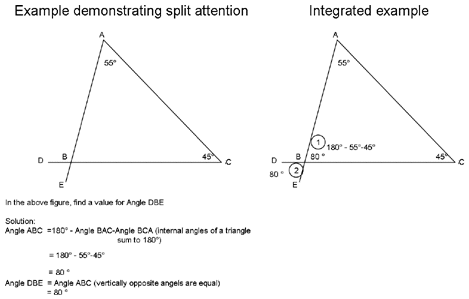Split attention effect
The split-attention effect is a learning effect inherent within some poorly designed instructional materials. It is apparent when the same modality (e.g. visual) is used for various types of information within the same display. To learn from these materials learners must split their attention between these materials to understand and use the materials provided.
A visual example of split attention
Consider the graphic below from Tarmizi and Sweller (1988). They used these graphics to compare the learning that takes place given split attention conditions. Each is a possibility of how one might arrange graphical material within a lesson. Ward and Sweller (1990) advise instructional designers to be careful when they direct a learner's attention. Sweller and his associates found that learners had difficulty following some worked examples if they included diagrams that were separated from their formulas. In several studies and over a variety of experiments, they found that learners using integrated diagrams were better able to process that information, and significantly improved their performance relative to their peers (Ward & Sweller, 1990; Chandler & Sweller, 1991; Chandler & Sweller, 1992).
The split-attention effect is not limited to geometry, Chandler and Sweller (1991) found that this effect extends to a variety of other disciplines and is simply a limitation of human information processing. This overload is the result of high visual cognitive load due to poor instructional design. By simply integrating formulas with diagrams, learners found it easier to integrate and process both forms of visual information and in turn they performed significantly better (Chandler & Sweller, 1991; Chandler & Sweller, 1992).

The left example produces split attention, however the right example enhances learning because it guides the learner's attention through the worked example. The split-attention effect is an important form of extraneous cognitive load that instructional designers should avoid.
Visual split-attention
Chandler and Sweller (1992) found through empirical study that the integration of text and diagrams reduces cognitive load and facilitates learning. They found that this effect is evident, when learners are required to split their attention between different sources of information (e.g., text and diagrams).
Split attention is important evidence of the cognitive load theory (that the working memory load of instructional materials is important in the design of instructional materials). Chandler and Sweller (1992) found that students viewing integrated instruction spent less time processing the materials and outperformed students in the split attention condition.
Auditory split attention
Moreno and Mayer (2000) found evidence for auditory split attention when they tested learners with both ambient environmental sounds and music as they learned from instructional materials. Animation is processed in a visual channel but must be converted to the auditory channel. The extraneous cognitive load imposed by music or environmental sounds were not conducive to learning.
These researchers studied learners that learned within an environment that had additional (extraneous) environmental sounds or music and found that learners performed significantly poorer on retention and transfer tests (Moreno, 2001).
See also
- Cognitive load
- Multimedia learning
- Worked-example effect
- Expertise reversal effect
References
- Chandler, P.; Sweller, J. (1991). "Cognitive load theory and the format of instruction". Cognition and Instruction 8 (4): 293–332. doi:10.1207/s1532690xci0804_2.
- Chandler, P.; Sweller, J. (1992). "The split-attention effect as a factor in the design of instruction". British Journal of Educational Psychology 62 (2): 233–246. doi:10.1111/j.2044-8279.1992.tb01017.x.
- Moreno, R.; Mayer, R. E. (2000). "A coherence effect in multimedia learning: The case for minimizing irrelevant sounds in the design of multimedia instructional messages". Journal of Educational Psychology 92 (1): 117–125. doi:10.1037/0022-0663.92.1.117.
- Moreno, R. (2001). Designing for understanding: A learner-centered approach to multimedia learning. In the Human-Computer Interaction Proceedings (pp. 248–250), Mahwah, NJ: Lawrence Erlbaum Associates.
- Tarmizi, R.A.; Sweller, J. (1988). "Guidance during mathematical problem solving". Journal of Educational Psychology 80 (4): 424–436. doi:10.1037/0022-0663.80.4.424.
- Ward, M.; Sweller, J. (1990). "Structuring effective worked examples". Cognition and Instruction 7 (1): 1–39. doi:10.1207/s1532690xci0701_1.